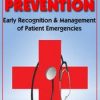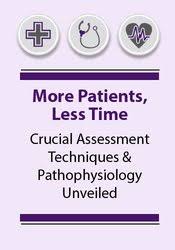More Patients, Less Time: Crucial Assessment Techniques & Pathophysiology Unveiled – Angelica F. Dizon
$200.00 Original price was: $200.00.$56.00Current price is: $56.00.
Proof of item:
Are you missing vital clues in your physical assessments?
In today’s clinical world, healthcare professionals are tasked with seeing more patients in less time… making it more important than ever that you conduct quick, yet precise head-to-toe assessments.
With this cutting-edge online course, you’ll get step-by-step guidance on how to quickly and thoroughly assess patients, understand the pathophysiology behind their condition, intervene effectively, and proper techniques to documenting your assessments and findings.
In 6 self-paced modules, you will be able to predict a differential diagnosis by identifying cardiac, respiratory and neurological disorders!
Walk away with advanced knowledge to:
- Interpret pathophysiology and differential diagnoses for crackles, wheezes, rhonchi and rubs
- Discuss management of obstructive vs. restrictive lung disease
- Practice a thorough 6-part neurological exam and document findings
- Distinguish whether abnormal S1 and S2 heart sounds are pathological or benign
- Outline an effective method to review options in pharmacologic therapy for any condition
- And so much more!
Improve your confidence, increase efficiency, and eliminate errors today!
Here’s what this intensive online course covers:
Hands-On Physical Assessment
Head-to-Toe Approach
Learn tips, tricks, and tools to conduct a quick and precise head-to-toe assessment.
- Assess the patient using the most comprehensive approach
- Evaluate baseline and identify patient status changes
- Devise tips and tools to perform a more efficient exam without missing key clues
- Conduct proper assessment skills – inspection, palpation, percussions, auscultation
Cardiac Exam
Knowing the different murmurs, their presentation, sounds and location to accurately pinpoint the disease process.
- Examination of mitral, tricuspid, pulmonary, and aortic
- Auscultation sites, sequencing and skills
- Characteristics of a functional murmur
- 7-point classification
- When does a murmur become pathologic?
- Strategies for detection of abnormal cardiac sounds
- First-hand partner demos: Practice and learn with examples
Respiratory Exam
Identifying the different breath sounds and their locations to narrow down diagnosis
- Physical assessment of the respiratory system – key points of normal anatomy to remember
- Identification of normal, abnormal, decreased or absent breath and lung sounds
- Assessment and techniques of Tactile Fremitus, percussion, lung auscultation
- Interpreting what you are hearing and what you should expect to hear:
- Bronchial, Broncho-vesicular, Vesicular Breath Sounds
- Bronchophony, Egophony, Whispered Pectoriloquy
- Death Rattle, Absent Breath Sounds
- Learning the adventitious sounds like Crackles, Rhonchi, Stridor, Wheezes and what to do with them
- What Lung Sounds to expect in different disease states
- First-hand partner demos: Practice with sounds: Listen, assess, and learn
Neurological Exam
Mastering the 6-Part components of a Neuro exam in less time.
- Unraveling the 6-Part components of a thorough Neurological Examination
- ABCT Components of Mental Status
- Key points and clues of using Confusion Assessment Method (CAM) Instrument and what can be diagnosed as a result
- Evaluate an efficient and accurate assessment of normal vs. abnormal findings for: altered mental status, cranial nerves, motor, sensory, cerebellar functions, reflexes
- Danger Signs for abnormal findings and how to identify diseases by physical examination
- First-hand partner demos: Practice with case studies and proper assessment
- Key clues you can’t miss
- Risk factors, readings, subjective and objective data
- Plan of care
Understanding Pathophysiology
Endocrine and Metabolic Problems
- Pituitary disorders
- Hypoglycemia
- Free radicals — Essential in health, deadly in disease
- Diabetic ketoacidosis
- Apoptosis
- Adrenal gland dysfunction
- Addison’s disease
- Jaundice
- Implications of hormones
- Thyroid disorders – Mechanism of onset affects treatment
Cardiovascular and Renal Problems
- Starling’s Law – Normal capillary flow
- Heart failure
- Relationship between cardiac diseases and hypertension
- Unraveling hypertension
- Current concept on cardiogenic shock
- Atherosclerosis – The role of inflammation
- Anaphylaxis
- Acid-base disorders
Respiratory Problems
- Chronic obstructive pulmonary disease exacerbations
- Obstructive lung diseases affecting the mechanics of lung ventilation
- Sudden death in asthma
- Acute lung failure/ARDS
- Arterial blood gases – Made simple
Shock
- Common mechanisms of all types of shock
- The cardinal role of mediators in shock
- Newer therapies based on current pathophysiological understanding
- End points of resuscitation
- What type of shock is this?
The Immune System
- Inflammation – Acute phase response
- Systemic inflammatory response
- Infection – Part of a bigger picture
- Multiple organ dysfunction syndrome
- Stress reaction
- Autoimmune diseases
Tag: “More Patients, Less Time: Crucial Assessment Techniques & Pathophysiology Unveiled – Angelica F. Dizon” Review. “More Patients, Less Time: Crucial Assessment Techniques & Pathophysiology Unveiled – Angelica F. Dizon” download. “More Patients, Less Time: Crucial Assessment Techniques & Pathophysiology Unveiled – Angelica F. Dizon” discount.
1 review for More Patients, Less Time: Crucial Assessment Techniques & Pathophysiology Unveiled – Angelica F. Dizon
| 5 star | 100 | 100% |
| 4 star | 0% | |
| 3 star | 0% | |
| 2 star | 0% | |
| 1 star | 0% |
Sorry, no reviews match your current selections
Q & A
Related products
Personal Development
Personal Development
Personal Development
Personal Development
Reuben Brooks – The Ultimate Transformation – Meal Plan & Training Program
Personal Development
Jess Lively – Magic Flow School – The Ultimate Course Bundle
Personal Development
Personal Development
Personal Development














Brand new | More Patients, Less Time: Crucial Assessment Techniques & Pathophysiology Unveiled – Angelica F. Dizon